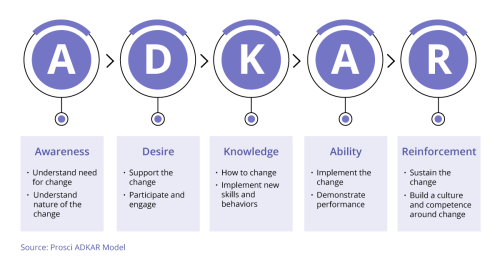Change Management Planning: 7 Helpful Tips to Engage Employees

Some people are enthusiastic about new and better ways of working, but others prefer a predictable workplace and may even actively resist change. As a manager, you have a mix of both on your team, and Change Management Planning will benefit everybody, the cheerleaders, and the resisters.
Changes that impact your workforce can come in many forms. Some of the most common are organizational (altering the managerial structure), acquisitional (merging, purchasing another company, or being sold), and physical (moving to another building). Others, like new software or a shift in priorities, affect employees more directly, modifying how they perform their day-to-day tasks.
Change Management Planning addresses hindrances before they happen. It ensures a smoother flow as your company transforms from its current circumstance to its future, improved state of being.
We’ll break down the most effective approach to a major workplace transformation with a guide to change management, and seven helpful ways to engage employees.
What is change management?
Change Management is how organizations prepare, support, and help employees to perform and deliver expected results during times of change. Sometimes, making a change in an organization can seem like attempting a U-turn with a loaded tractor-trailer. But a sure path to jack-knifing is to unilaterally implement fundamental changes and merely hope they are accepted and catch on.
Let’s say you’ve decided to toss out the old workplace binder and join other organizations that have upgraded to the ease of using ProcedureFlow for managing their processes and procedures. ProcedureFlow is a cloud-based knowledge management solution. It allows agents to instantly access the right information as they navigate a wide variety of standard operating procedures. You have wisely decided it’s a valuable tool that will improve productivity and, the bottom line.
Now you must decide the best way to inform your staff. Remembering the outcry when you replaced the break room coffee provider causes you to pause before acting. You don’t want to go through that near mutiny again. And this is change on a much bigger scale. (Although we mustn’t undervalue the importance of access to good coffee.)
Change Management is the strategy you should use to roll out the information about the upcoming improvement, manage it as it’s put into practice, and monitor its use and effectiveness. Change Management Planning is the antidote to “springing it” on your staff and expecting them to respond in a positive way. By actively managing the change and inviting consultation, you will virtually guarantee buy-in from the team.
What is a change management plan?
A change management plan is a roadmap to guide your organization from concept through execution and gauge the results of your desired change. It begins with who’s responsible, sometimes called a sponsor of the change. And it carries through the steps for implementation followed by analyzing metrics that prove the positive outcome that prompted the desire for the change in the first place.

What is needed in a change management plan?
Successful Change Management Planning is like the manual that came with your food processor. It identifies all the parts, explains how to use the machine, and includes troubleshooting in case of unforeseen issues.
A change management plan also needs to identify the parts, all those who participate in and are affected by the change. It carries through the implementation, or operation of the change. And it identifies any potential snags that may arise, and how to manage them. This could include consequences for anyone who refuses to get on board.
Unlike the appliance guide, a change management plan should also answer the “why” aspect of the change that’s being made. Manufacturers assume you already know why you want the food processor.
“Why” questions to be ready for include but aren’t limited to, why are we going to this effort? Why is it necessary? And why do you believe it’s going to be worth it? Beginning with a solid foundation for embarking on this process will provide you with the answers to your “why” questions and ensure a quicker buy-in from staff.
What is the correct sequence of steps in the Change Management Process?
The Prosci Methodology developed by the change management firm, Prosci, is used widely around the world. Their scalable and adaptable tactic consists of three phases.
Phase One is to prepare the approach to the change. This includes developing a customized strategy for unfolding the desired change.
Phase Two is managing the change by creating and adapting plans to implement it and following through.
Phase Three is about sustaining outcomes by ensuring the change is being adopted and affirming a commitment to stay with it.
What are the essential elements of change management?
Centered on the philosophy that “individual success leads to organizational success,” Prosci’s ADKAR model of change management identifies five key elements.

Best practices for change management
Data shows that initiatives with excellent change management are six times more likely to meet their objectives. Effective Change Management Planning motivates employees and encourages facilitates employee engagement and fosters a team approach to the challenge.
Granted, there will be a learning curve, but it will be easier to navigate when everyone’s prepared for it with proper Change Management Planning.
Here are seven strategies for increasing employee engagement as you embark on this exciting endeavor.
- Focus on the employee. The changes you’ve identified will benefit your customers and increase productivity which translates into cost savings. But none of that is possible without proper execution on the shop floor. Bring employees into the conversation early, so they’re part of the process and have a say in how it’s done
- Don’t rush. There may be a desire to start with the new process/software/structure as soon as possible. But getting it right is preferable to hurrying into disaster.
- Lead by example. If you’ve already familiarized yourself with what they’re expected to learn, it will instill confidence and command respect.
- Communicate, communicate, communicate. Give regular updates, reassurance, and repetition of the purpose for the change.
- Actively listen. There’s always a Debbie Downer in the crowd, but sometimes there’s a legitimate reason for worry. Offer a clear pathway for employees to share their concerns.
- State clear expectations and, consequences. Staff wants to know their effort won’t be wasted if someone fails to follow through.
- Share results. When proof of positive results is available, make it known. Not only will this justify the process, but it will also add to the determination to make the transition a success.
Conclusion
Change is essential for survival. An organization must remain agile so it can pivot, when necessary, to adjust to market conditions and industry trends. Whatever the change, there’s a greater opportunity to make it happen and make it stick, with solid Change Management Planning to guide you. ProcedureFlow is here to help make that change a success. Book a demo today.
Written by Lisa Brandt


